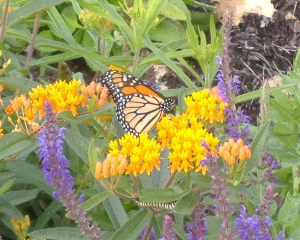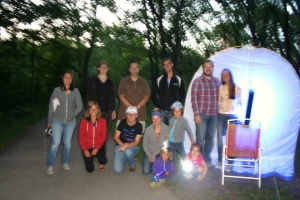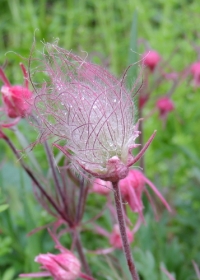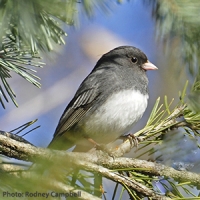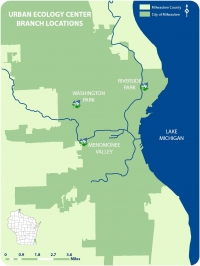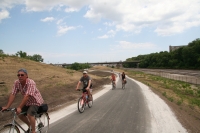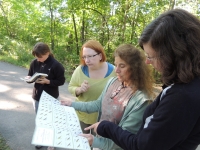
Anne Reis
Anne has conducted research on a variety of topics including cranberries, potatoes, wetlands, lichens, tamaracks, and most recently bats. She has a B.S. and M.S. in Horticulture from UW-Madison and a M.S. in Biological Sciences and a GIS Certificate from UW-Milwaukee. Anne is the GIS Specialist at the Center and enjoys reading, mapping, gardening, and spending time outside with her husband and daughter in the Riverwest neighborhood.
Green Birding Challenge Recap
Thank you to everyone who helped make the 5th Annual Green Birding Challenge a success! 19 teams, comprised of both experienced and fledgling birders, participated in this year's challenge and observed over 100 distinct bird species in a fossil fuel free search around the city. Their efforts inspried more than 150 generous donors to pledge $8,000 for the Center's Citzien Science program. Wow! Read on for more fun facts and photos from the day's birding adventure!
Research Highlight: Castor canadensis in Riverside Park!
On July 30th, Jennifer Callaghan, the Center’s Research & Community Science Coordinator, returned to the office with visual evidence of an extremely rare species in Riverside Park! One of the large cottonwoods along the Milwaukee River (just north of the Riverside Park canoe launch) was clearly chewed on by an American Beaver! The images at right show the extent of chew on August 13th and then again a little over a month later on September 18th. While Castor canadensis is common in the Great Lakes basin, they are not often seen in heavily urbanized areas. After almost 8 years of wildlife camera surveys, this is the first time we’ve ever photographically documented a beaver!
Research Highlight: Migrating Monarchs!
I recently read Barbara Kingsolver's latest novel, Flight Behavior, which is a fictional story about the disruption of eastern U.S. monarch migration patterns in response to the changing climate. As always, Kingsolver writes exquisitely about the raw beauty of the natural world. The story centers around a fictional occurrence of thousands of adult monarchs overwintering on a mountain in Tennessee, lighting the mountain on metaphorical fire. Kingsolver's female protagonist, despite having little formal science education, has the necessary curiosity to make insightful observations and pose thoughtful questions about this unexpected phenomenon. The novel elucidates the importance of understanding the scientific process and how the media portrays scientific findings. The book persuaded me to learn more about the charismatic monarch butterfly.
Research Highlight: Much Ado About Mothing
Did you know that there are roughly 10,000 species of moths in North America? Moths are under-studied yet important pollinators of certain plants, and their populations may be impacted by human activity such as urbanization and pollution. Studying moths allows us to gain a better understanding of how this group of pollinators may change over time, especially in an urbanized setting, and even allow us to monitor or infer the impacts of other organisms.
Research Highlight: Share your Urban Ecology Center wildlife sightings - there's an App for that!
Many of the Urban Ecology Center staff, volunteers and community members love taking photographs of the wildlife and vegetation in our parks. Who can discount the natural beauty of an unfurling fiddlehead or the pure white flower of the bloodroot? Many photographers find the natural world a source of limitless inspiration for their art. Others take photographs to record phenological observations. Phenology is the study of the timing of natural events, such as the first bud break, the first appearance of a migratory animal, the making and breaking of ice on lakes and more. The first appearance of the nodding head of the yellow trout lily is not only photogenic, but it is also a harbinger of spring. The date of bloom is a phenological record and here at the Center, we like to record these observations. In fact, there is a long standing—and fierce—competition to observe the first chipmunk of the year.
Say Hello to the Junco!
The Galapagos Finches were crucial to Darwin’s understanding of natural selection and evolution, but did you know that evolutionary scientists have been studying a more common and locally distributed species for over a century? Learn more about the extraordinary importance of this ordinary bird as we screen the film Ordinary Extraordinary Junco.
Research Highlight: Green Birding Challenge
Spring migration is one of the Research and Community Science Team's favorite times of year. For the fourth year in a row, we are hosting our Green Birding Challenge (GBC), the Team's signature annual fundraiser! Do you enjoy spending time outdoors hiking or biking, or just sitting and listening to the sounds of nature? If so, this year's GBC, held on Saturday, May 10th, is the event for you! Get out your walking shoes, dust off your lawnchair or pump up your bike tires and participate in a little competitive birding. Register a team for one of our four challenges: stationary birding, birding on foot, birding by bike, or a mini-challenge. Your participation will help us celebrate International Migratory Bird Day and help raise money for bird conservation and community science!
Research Highlight: GIS and Mapping
A recent NPR segment on All Things Considered reported some sad news - but brought the acronym “GIS” to light. The father of GIS (geographic information systems), Roger Tomlinson, passed away in early February. He was the first person to devise a computer software to overlay different types of map layers on top of one another, thereby efficiently revealing physical and biological patterns in a landscape or area and streamlining analyses of these patterns. Using current GIS software, the Urban Ecology Center has been able to map a variety of data about our branches and parks.
Research Highlight: Park Use Surveys
Did you know that the Urban Ecology Center collects data throughout our three parks to help us understand the impact of our work on making parks safe, accessible and ecologically vibrant for people living in the community? In the fall of 2012, a UW-Milwaukee undergraduate research intern devised a park use survey protocol to help estimate attendance and assess the types of activities people engage in when they visit the parks near our branches. Our park use surveys compare park use from branch to branch, season to season, and year to year. Data is collected on a seasonal basis, for every day of the week during different times of the day.
Research and Citizen Science: Gear Shift
October marks a bittersweet time in the annual cycle for the Research & Community Science crew. Summer is over, and along with it, go the warm temperatures, lush vegetation, and abundant wildlife. Many animals are starting to head south for the winter or are making their way toward hibernation areas. Additionally, we have come to the end of our 3-year Great Lakes Restoration Initiative (GLRI) research and restoration grant from the EPA that helped create the Milwaukee Rotary Centennial Arboretum. On the bright side, it's now the time to process the variety of data we have collected over the past three field seasons and start looking for trends or changes!
Copyright © 2023 The Urban Ecology Center



